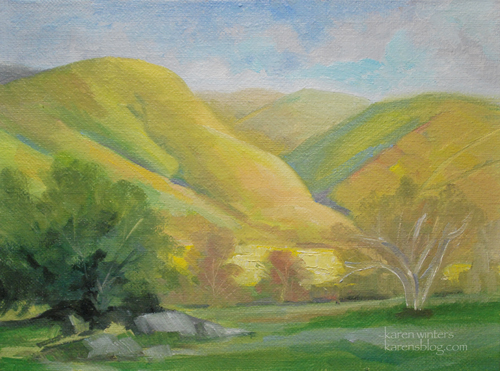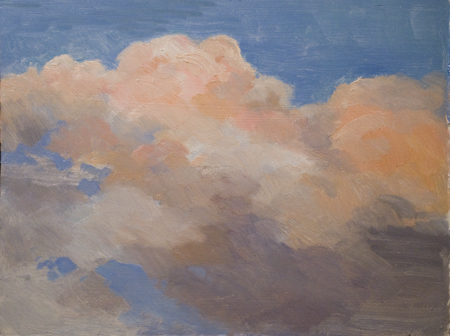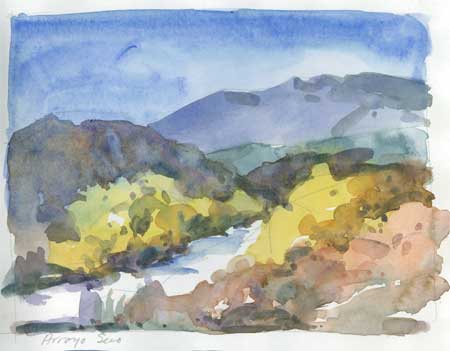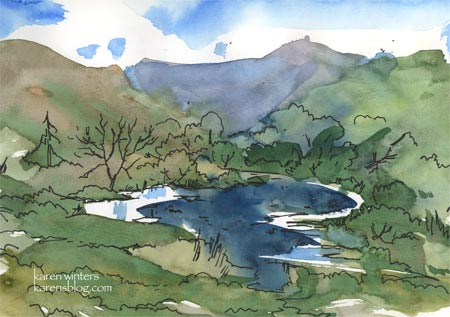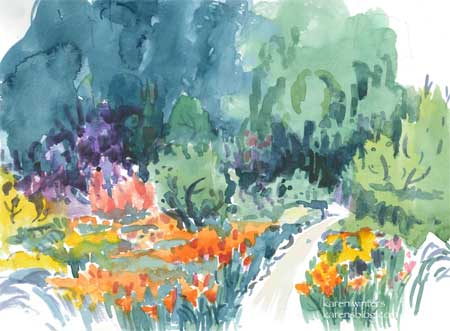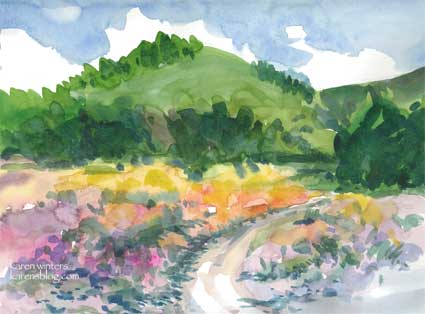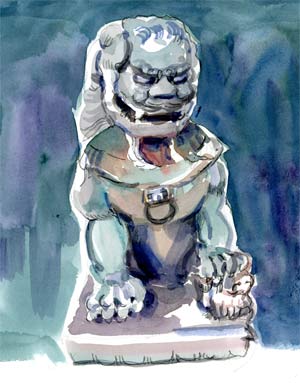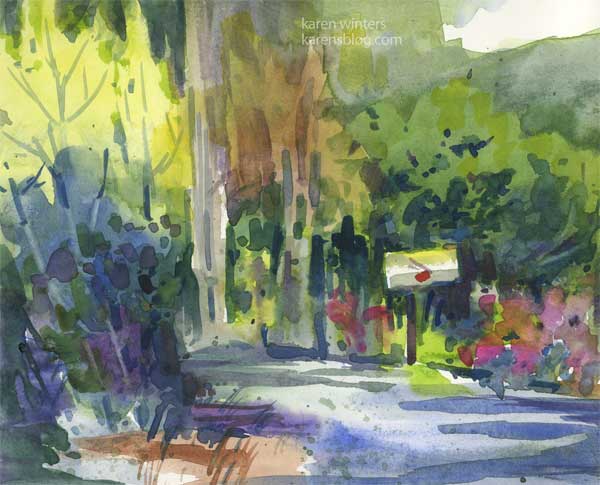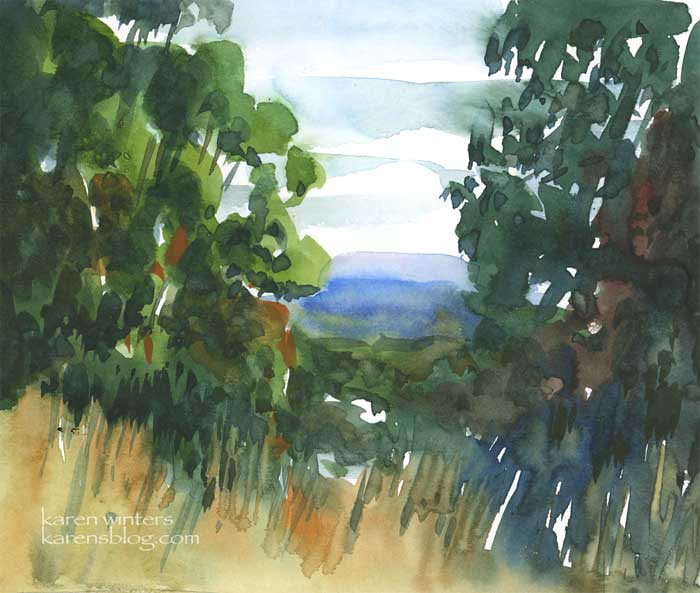California poppy wildflower landscape oil painting – Golden Hills of Springtime – by Karen Winters
“Golden Hills of Springtime”
6 x 8 oil painting study
on linen panel
See more of my California wildflower paintings here
The foothills of the Sierra, when the weather is right, are draped in magical hues of gold, green, violet, white and orange. Amazingly, all at once. This living tapestry extends throughout the range, creating an almost mystical impression. Upon closer examination we see that California poppies grow in drifts next to white “popcorn” flowers. Fiddleheads – small yellow flowers – cover entire meadows – not to be confused with the fiddlehead appearance of opening ferns. Blue lupine provides a welcome complement. In this study I was making some changes to the actual appearance of the landforms, and experimenting with color harmony. With one small exception (a bit of ultramarine blue in the sky) this was painted with three primaries and white.
Cloud study – California impressionist oil painting
Cloud study
6 x 8
oil on gessoed wood
We’ve had some unusual storm activity in the past week, including some huge thunderheads that appeared in the distance last night. As the sunset glow touched them, I tried to memorize the colors and immediately came indoors to get down a quick impression.
When I was last at the Irvine Museum, I saw a whole collection of cloud studies done by Frank Cuprien. I think they were about 8 x 10 inches, no bigger than that. Displayed on a wall together they made an interesting collection.
I enjoy studying how different early California impressionists painted certain natural features, like clouds, water reflections, particular species of trees and so forth. Some, like William Wendt prefer heavier paint and active brushwork. Others, like John Frost, had a lighter hand.
Arroyo Seco Path – California watercolor sketch
Arroyo Seco Path
7″ x 5.5″ watercolor sketch
For more information about my work, please write
One of the most frequent questions I get about my paintings is whether they are all done plein air style (no) and, if not, what I use for reference. Although I do use photos to catch specific details of trees and structures, especially when painting architecture, one of my most valuable tools is my sketchbook. Because my roots are in watercolor, I usually do plein air sketches using that medium. This is a quick way to get color notes and the general layout of a landscape subject without having to fuss with too much detail.
General color areas are indicated with a quick wash. The colors of the shadows can be added when those are dry (and outdoors, watercolor dries fast!)
Using watercolor as a plein air medium has a long history among 19th century painters, and noteworthy is John Constable. His field work formed the basis for his later oil paintings. Eugene Delacroix followed the same practice.
Watercolor painting has the benefit of being quick and portable, and it is a good way to capture the mood with few strokes. Although I love plein air oil painting and do it as often as I can, it’s not always easy to set up an easel. But a watercolor sketchbook can be opened and put to use in a few minutes. A portable watercolor palette, a spray bottle, a collapsible water bucket and a few brushes, some paper towels and I’m good to go. And I can carry a kit in the car so it’s handy at any opportunity.
Mountain Sketch – Karen Winters Daily Painting
“Mountain Sketch”
approx 8.5 x 11 watercolor
Well, I’m in countdown mode again – looking forward to the Sierra Madre Art Fair benefitting Friends of the Sierra Madre Library in (where else?) beautiful Sierra Madre, California, just a bit northeast of Pasadena.
So I’ll be posting some smaller sketches and paintings this week as I get my framing completed and gather together other items for sale.
This sketchbook study was painted with watercolor first – then the ink was added. It’s a little different from the way I usually work, but my objective was to think about color and shape more than line – hence the “reverse” order.
Poppy Patch – Pasadena – Karen Winters Daily Painting
“Return to the Poppy Patch” 9 x 12 watercolor
SOLD
It’s another walk around the Arlington street poppy garden, but this time in a more decorative, somewhat abstract mood. I abandoned any attempt to be realistic and considered the landscape as a decorative tapestry, with different colors and textures woven through. With some modifications, this might scale up well into a larger painting. But then I’d have to fight the temptation to put in all sorts of fiddly realistic details. Can’t you just imagine Dorothy, Toto and the gang taking a nap back there between the poppies and the irises? We’re not in Kansas anymore. We’re in Pasadena.
A Spring Walk – Karen Winters Daily Painting
A Spring Walk – 9 x 12 – watercolor sketch
This one is a little bit from real life, and a little bit from imagination. I embellished the wildflower strewn meadows just a tad beyond reality, but if you don’t tell, I won’t.
Ah, springtime. Our peach tree is in bloom, magnolias are covered with blossoms and the mustard is starting to blanket whole hillsides in a warm yellow glow. I’m looking forward to getting out and painting again soon, now that the rush to deliver paintings to shows is almost over. I have more deadlines ahead of me for other shows yet on the horizon, but there is a bit of a breather, at least.
And speaking of shows, the “Warm Welcome” watercolor of the Chevy Chase clubhouse garden and front door was purchased today, two days before the opening reception. I am very pleased and hope that the new owner enjoys it as much as I did painting it, although it will hang for the duration of the show. I hope this is a good omen for the rest of the show.
Someone asked me the other day if I felt stress painting to deadlines for shows and competitions. I thought for a moment and realized, yes, I feel stress, but it doesn’t feel like a negative pressure – just busy-ness. It causes me to focus and be deliberate about what I’m doing, but it’s not a bad feeling. Quite the contrary!
Did you know that there are actually two kinds of stress? One, the one we think of commonly, is actually distress. It makes us feel bad. The other kind of stress, associated with good things, is called “eustress.” Here’s a link, look it up! So when I’m painting to a deadline, I feel eustress and it actually energizes me. I think this is the kind of stress people refer to when they say “I do my best work under pressure.” Distress, on the other hand, tends to paralyze you and make you lose focus and confidence. That kind of stress makes you avoid the project instead of looking forward to the next one. So, as a long way of answering, I do feel stress, but it’s the kind that makes me want to jump out of bed in the morning and get to work, not to pull the covers over my head!
And since it’s past midnight right now, I think I’ll go pull the covers over my head and hopefully dream about walking down that spring path.
Foo Dog
While I work on some large paintings, here’s a small watercolor sketch of a lion dog, also known as a foo dog. It is one of two guardians of the new Chinese garden, opening very soon at the Huntington Library and Gardens in San Marino. According to this article the one I drew is the female because she has a cub underneath her paw. The pair of foo dogs stand by the pathway that leads to the new feature of these beautiful gardens.
A Life Drawing
Female portrait – for practice – charcoal on newsprint
One of my goals this year was to take a life drawing class – working from a live model. I’ve drawn from models on some other occasions but i was never close enough to get a good look at the head, and the models were nude which encouraged drawing the whole form, not just the head. They were also uninstructed events with short to medium length poses, not conducive to a slow study.
So this was the result from class 2, as far as we took it. We worked for about an hour or so because some of the time was spent in demo and lecture and some breaks. With more time I would have made this a more refined and corrected image, but when the model is done, time’s up. For scale, the top of the head to base of the neck is about 10.5 inches.
By far the hardest part for me was the seeing. My eyesight was poor as a child and hasn’t gotten better as I’ve grown up. And although I’ve tried many different kinds of glasses with a variety of magnifications, there’s always some compromise. I was about 8-10 feet from the model, I’d guess. If she had been sitting at arm’s length or 4-5 feet I think I could have done considerably better. The model was strongly lit from the top and to the right (camera right, not her right) which gave good shadows to work with and model form.
Eventually I think we’ll be drawing her unclothed and I may or may not post them, it depends upon whether or not that’s ok with her. She is a patient and friendly person and holds a pose remarkably well. She was very pleased to have a looking down position because it allowed her to read a book last night!
My objective with this, of course, is to work into oil portraiture. But as I’ve been reminded by the teacher, all practice drawing shape and value helps improve any kind of painting – including landscapes and still life. It’s additive and no practice is every wasted.
No Mail Today – Karen Winters Daily Painting
No Mail Today – 8 x 6.25 – watercolor sketch
I painted this little vignette this morning as a way to get some art practice no matter what the rest of the day would include (chores, an art association meeting and demo, car-shopping, housework, etc.) I’m very disciplined about making sure that I paint daily – and now I know why. At yesterday’s Watercolor West demo featuring Elaine Harvey (watercolorist) she said it’s essential to practice frequently because painting is not just an intellectual activity – it’s a physical activity. If you don’t paint for awhile she says, you lose some of your dexterity in brush handling, color mixing, just the way you move your hand and move paint around. I hadn’t really looked at it that way but I can see the wisdom in it and will continue making time for at least one painting or sketch a day – more if I can afford the time.
This little sketch is a bit of a fantasy based on a little picture I took last summer of a country road. It looks nothing like this in real life but it does capture a little bit of a peaceful, cheerful country feel, in a completely romanticized way. Every now and then it’s sort of fun to escape from the mud and muck of reality. Like, during the US election season, you know?
A distant view – daily painting
“A distant view” – watercolor sketch on paper
The cold and flu season has left me a sniffling, coughing, Vicks-laden mess, so I’m trying to not exacerbate the situation by inhaling copious quantities of odorless mineral spirits without a window open for ventilation. (It’s cold outside.) So instead, I’m keeping warm, drinking lots of tea and doing some watercolor studies in preparation for larger paintings, to be completed at a later time. But it still fits within my yearly goals, and I’m content with that.
A word about goals and plans. Many of our art friends are making goal lists this time of year, and I see at least two different types of plans. Some goals are highly specific and detailed, often including numbers of types of works to be drawn or painted, or lists of subjects to be tackled. I think that this can work very well for people who enjoy structure and thrive on that – and you are to be congratulated for having thought through your plans in such detail. And there are others, myself included, who work better with a few broad guidelines and plenty of room for variety. I also find that I produce more when I set my goals low and try to exceed them than when I set them too high and then feel internally nagged to do “too much.”
So whether you’re a wonderfully detailed goal-setter or a ‘big umbrella’ goal setter, I encourage you to be thoughtful about your plans and allow room for the unexpected to happen. You may have intended to work on pen and ink drawing – but then you synchronistically meet a pastellist whose work just blows you away – and who is offering a workshop within driving distance. Sometimes these chance meetings can have extraordinarily wonderful consequences, so leave room in your plans for serendipity, without judging yourself for changing mid-stream.
Fixed forecasts may work in the financial sector but artists need to have room to course correct as the muse moves them. Now, I’m not saying you should “change your major” with every passing whim – that’s a good way to end up going in circles. But do allow yourself the freedom to be inspired by new ideas, and to follow those interests where they lead – even if they weren’t on your radar in January.
